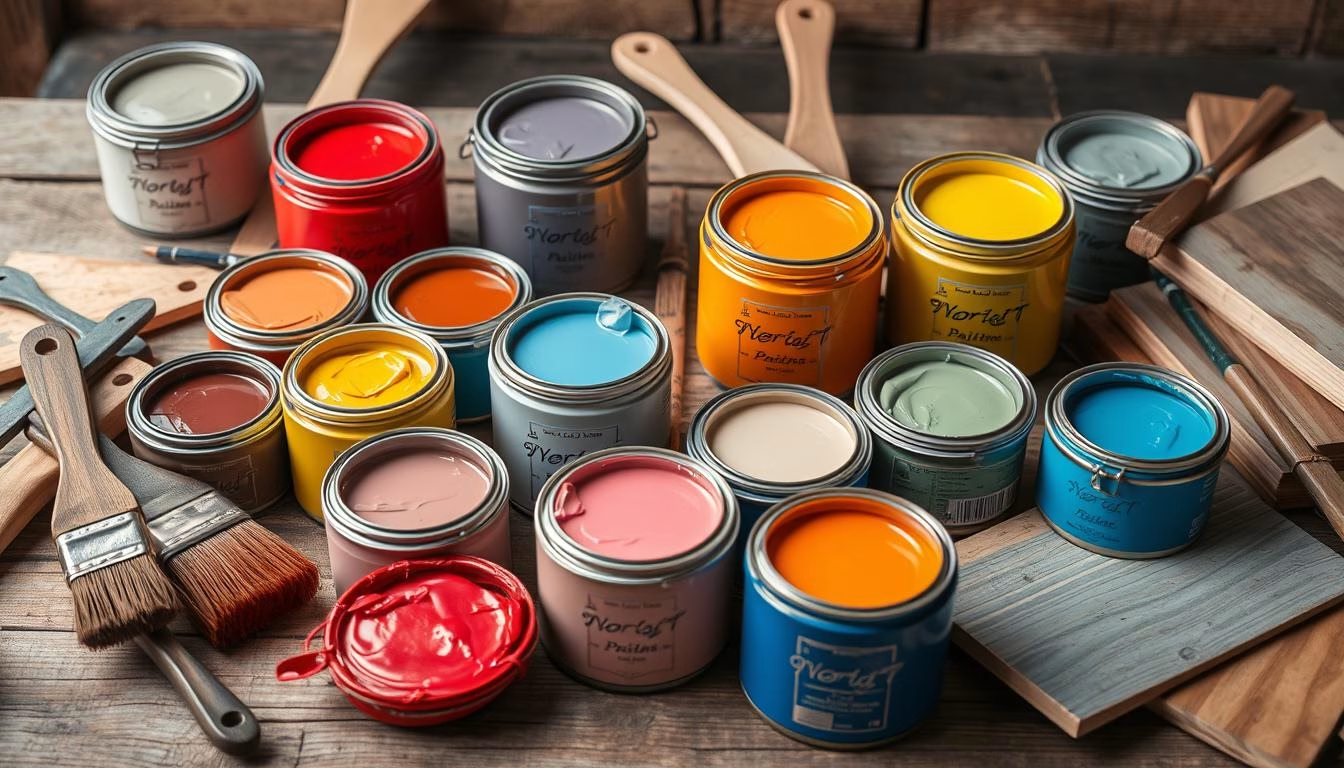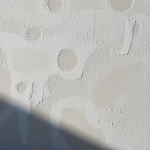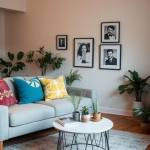Did you know the global wood coatings market is set to hit $11.2 billion by 2025? With so many choices, picking the right wood paint can feel overwhelming. But knowing the special qualities of each paint type can guide you. This ensures your wood stays protected and looks great.
Whether you’re updating an antique or refreshing your home’s exterior, the paint choice matters. Oil-based paints are durable, latex is versatile, and acrylics offer great coverage. Each has its own benefits for different projects.
In this guide, we’ll cover what to look for in wood paint. We’ll also highlight top brands and share tips for prep, application, and upkeep. You’ll learn how to achieve a flawless finish that lasts.
Key Takeaways
- Understand the unique properties of oil-based, latex, and acrylic wood paints to choose the right option for your project.
- Consider climate conditions, paint quality, sheen, and VOC levels when selecting the best wood paint.
- Explore top wood paint brands that offer a range of products tailored for both interior and exterior applications.
- Learn proper wood preparation, paint application techniques, and maintenance tips for a long-lasting, beautiful finish.
- Embrace sustainable wood painting practices to minimize environmental impact and ensure the longevity of your projects.
Understanding Different Types of Wood Paint
There are three main types of wood paints: oil-based, latex (water-based), and acrylic. Each has its own benefits and drawbacks. It’s key to know the differences to pick the right one for your project.
Oil-Based Paint: Oil-based paints are durable and resist moisture well. They give a glossy look and last long against fading, chipping, and scratches. But, they smell strong and take longer to dry, sometimes days.
Latex (Water-Based) Paint: Latex paints are versatile and dry fast, usually in 1-2 hours. They’re better for the environment and resist UV light well. They’re great for indoor wood, like cabinets and trim.
Acrylic Paint: Acrylic paints cover well and resist fading. They dry quickly and are easy to clean up. But, they might not last as long outdoors and might need extra protection.
When choosing paint, think about where it will go, the finish you want, and how much protection it needs. Knowing what each paint type offers helps you make the best choice for your project.
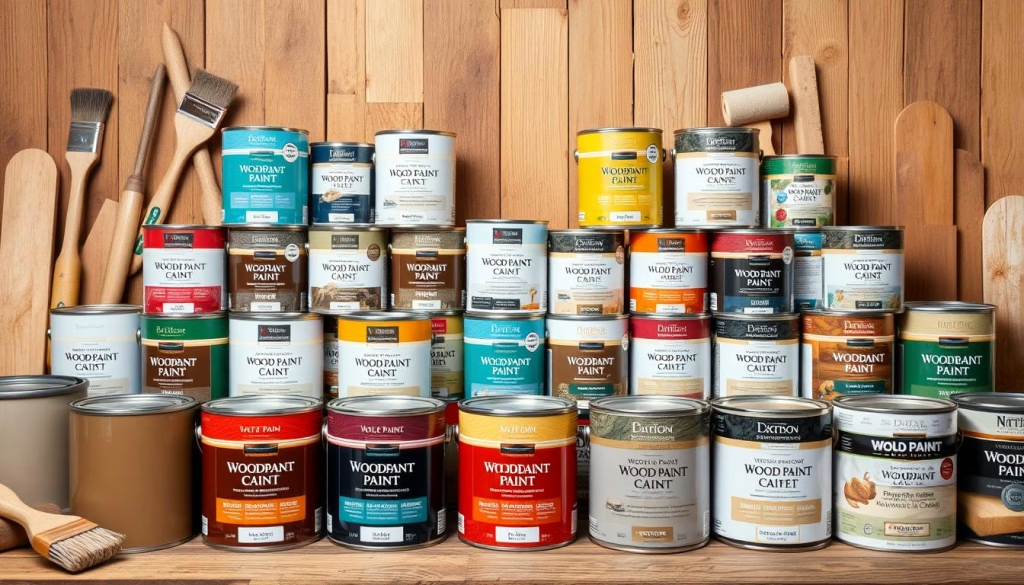
Key Features to Look for in Wood Paint
When picking the right wood paint, look for a few key things. Wood paint durability is key, as you want it to last for years. Weather-resistant paint is also important, especially for outdoor projects. It keeps the wood safe from moisture, UV rays, and fading.
Also, the low VOC content of the paint matters a lot. Low VOC paints are better for the planet and safer to use. They release fewer harmful chemicals, making them a greener choice.
- Durability: Choose paints that can handle wear and tear, offering long-lasting protection for your wood surfaces.
- Weather Resistance: Pick paints that fight off sun, rain, and other environmental factors.
- Low VOC Content: Go for paints with low levels of volatile organic compounds for a safer, more sustainable painting experience.
By focusing on these features, you can pick a wood paint that looks great and lasts long. It will protect your project and keep it looking good for years.
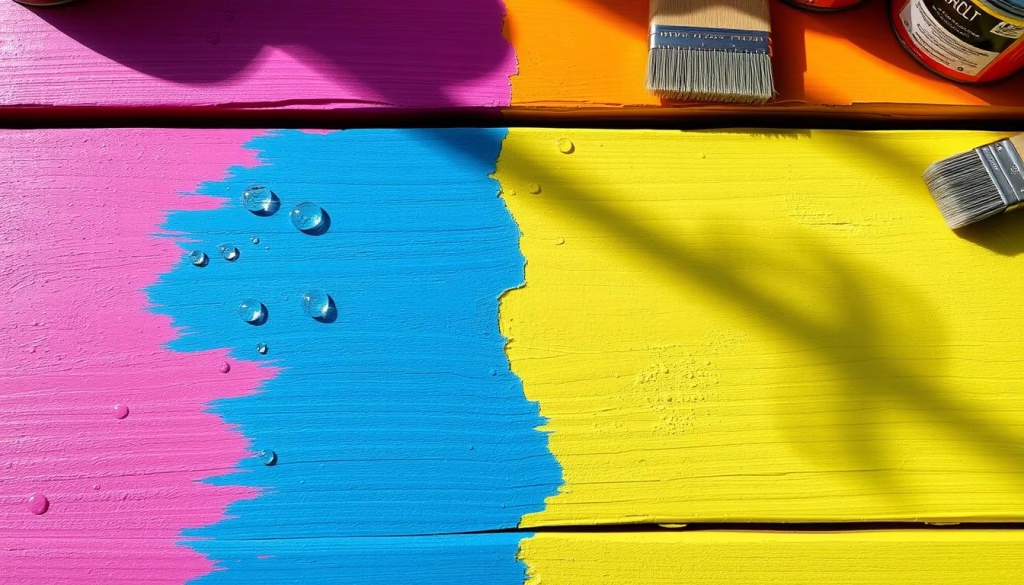
“The right wood paint can transform a project and provide long-lasting protection, so it’s important to choose wisely.”
Top Wood Paint Brands to Consider
When painting wood surfaces, both indoors and outdoors, Benjamin Moore, Sherwin-Williams, and Rust-Oleum are top picks. Each brand has unique benefits for different needs and tastes.
Benjamin Moore is known for its high-quality paints. They keep colors vibrant and last long. You’ll find the right shade for your project, from bright colors to timeless neutrals.
Sherwin-Williams offers a wide range of wood paints. They work well on various surfaces, like furniture and fences. Their paints cover well, apply easily, and protect for a long time.
Rust-Oleum is a go-to for wood paint that’s both affordable and durable. Their formulas resist weather, making them great for outdoor use.
| Brand | Key Features | Ideal for |
|---|---|---|
| Benjamin Moore | Premium quality, excellent color retention | Indoor and outdoor wood projects |
| Sherwin-Williams | Versatile options, easy application, durable protection | Furniture, fences, and more |
| Rust-Oleum | Value-for-money, weather-resistant formulas | Outdoor wood surfaces |
These leading wood paint brands have a wide selection for any wood painting task. They help you get professional results and protect your wood for years, indoors and outdoors.
“The author has used over 15 different product lines and brands for painting furniture, and the types of paint recommended are very low to no volatile organic compounds (VOCs), enabling indoor painting without fumes.”
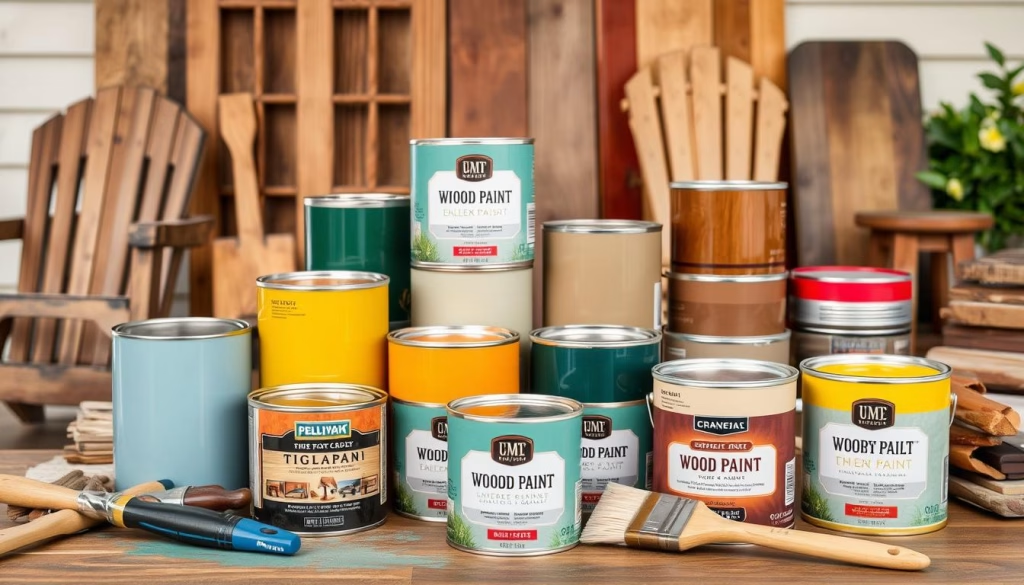
How to Choose the Right Wood Paint for Your Project
Choosing the right wood paint is all about the surface, where you’ll use it, and the color you want. Knowing what each paint type does helps you pick the best one. This ensures your project looks great and lasts a long time.
For outdoor projects, you need paint that can handle the weather. Oil-based paints work well on hardwoods like birch and maple. They give a smooth look and last a long time. Acrylic paints are great for furniture and decorations. They have lots of color and look even.
Indoor painting is different. You want paint with low VOCs. Latex paints are good for places that don’t get a lot of use. They dry fast and are easy to clean. Water-based paints, like chalk and milk, are also good. They’re durable and don’t smell as much as latex.
For a look that lasts, choose neutral colors like tan, beige, and white. They fade less on the outside. But, if you want to make a statement, use bolder colors on things like front doors.
The best paint for your project depends on what you need and what you want it to look like. Think about how the paint performs, how easy it is to use, and the colors it comes in. This way, your wood will look amazing for years.
| Paint Type | Recommended Use | Key Features |
|---|---|---|
| Oil-based | Hardwoods (birch, maple) | Smooth finish, durable |
| Acrylic | Wooden furniture, decorations, crafts | High pigment, smooth finish |
| Latex | Low-traffic areas, infrequently used furniture | Quick drying, easy cleanup |
| Water-based (chalk, milk, alkyd) | Durable, less odorous | Mold/mildew resistant, fade resistant |
Preparing Wood for Painting
Getting your wood ready for painting is key to a great finish. You need to clean, sand, and prime it well.
Cleaning the Wood
First, clean the wood to get rid of dirt, grease, and old paint. Use a soap and water mix, then rinse and dry it well. For tough stains, try a TSP cleaner or a degreaser.
Sanding the Surface
- Use an orbital sander or sand by hand with 180-grit and 220-grit sandpaper. This makes the surface smooth.
- Wear a dust mask, eye protection, and ear protection while sanding.
- Use a vacuum or tack cloth to clean up dust after sanding.
Priming the Wood
Priming is a good idea, especially for outdoor projects or when switching paint types. Even if your paint has primer, a separate one can help with adhesion and coverage.
| Tool | Recommendation |
|---|---|
| Paintbrush | 2 1/2-inch paintbrush |
| Sander | Orbital sander |
| Protective Gear | Dust mask, eye protection, hearing protection |
| Gloves | Rubber gloves |
| Cleaning Supplies | Bucket, clean cloths, shop vacuum |
| Painting Supplies | Roller assembly with high-density foam cover, paint tray, liner, putty knife, stir stick |
| Paint and Primer | Interior acrylic-latex paint and primer |
By cleaning, sanding, and priming your wood, you’ll get a smooth surface. This leads to a professional and lasting finish.
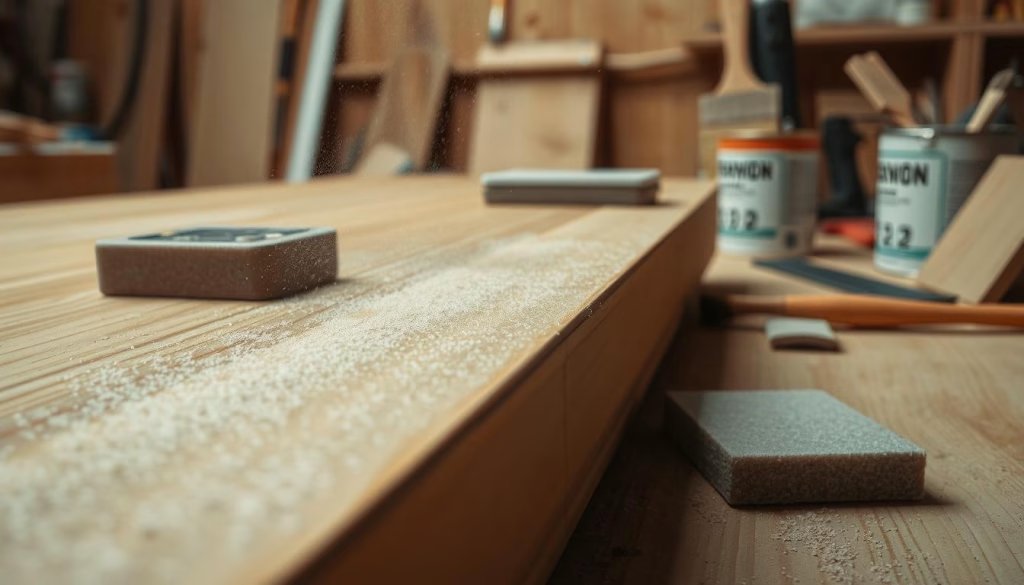
Applying Wood Paint: Techniques and Tips
Getting wood paint right means picking the right tools and methods. Brushes, rollers, and sprayers each have their strengths. For the best look, apply thin coats of paint, not one thick one. Always check the drying times between coats as the maker suggests.
Outdoor painting needs careful planning with the weather in mind. Paint in mild, dry conditions for a lasting finish.
Painting Techniques
- Brushing: Great for detailed work, edges, and hard spots. Use a good brush that fits the job.
- Rolling: Fast for big, flat areas. Pick a roller that matches the wood’s texture.
- Spraying: Smooth and even, perfect for complex shapes. Needs the right gear and skill to avoid mess.
Paint Application Tips
- Make the wood surface ready by sanding and cleaning for better paint stick.
- Use a primer or sealer if needed for a smooth paint base.
- Stir the paint well before painting for even color and texture.
- Paint in thin, even layers, letting each dry fully before adding more.
- Focus on edges, corners, and tricky spots for full coverage.
- Keep a wet edge to avoid brush or roller marks.
- Wash your tools right after painting to make them last longer.
By using these methods and tips, you can get a stunning wood paint finish for any project.
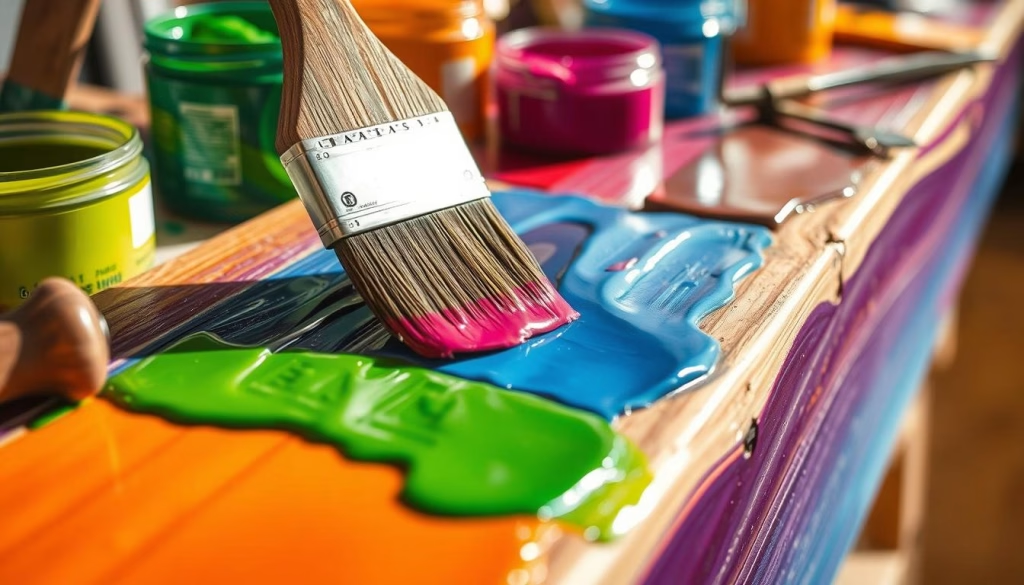
Finishing Touches: Sealers and Topcoats
Painting wood surfaces isn’t complete without sealers and topcoats. These finishes make your painted wood last longer. They also protect it, especially if it’s outside and faces harsh weather.
It’s important to pick the right sealers and topcoats. They should match the paint you used and fit the project’s needs. Eco-friendly options are available for those who care about the environment.
The High Performance Polyurethane Water Based Topcoat is a top choice. It won Fine Woodworking’s Best Overall Choice Award. For something versatile, try the Enduro-Var Water Based Polyurethane Varnish. It comes in finishes from flat to gloss.
Start with a water-based sanding sealer before your final topcoat. This ensures a smooth finish. You can also use extenders and accelerators for better results.
“Applying at least two coats of acrylic paint on wood furniture is recommended for a smooth and even finish. Curing times for painted furniture may vary, typically taking about 1-2 weeks for the paint and topcoat to harden completely.”
Quality tools and good ventilation are key for great wood painting results. Always test finishes on a small area first.
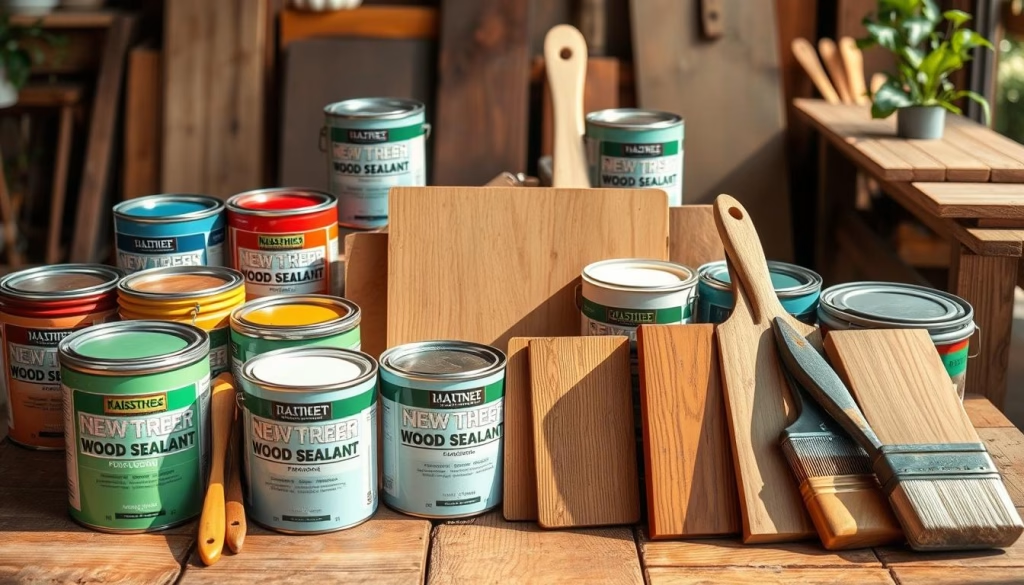
Troubleshooting Common Painting Issues
Painting can be a fun DIY project, but it comes with its own set of challenges. Issues like paint blistering and fading can happen. So can streaks and uneven coverage. Knowing how to fix these problems is crucial for a perfect finish.
Paint Blistering: Blistering is a common problem where paint forms bumps. It’s usually caused by moisture or applying paint to a dirty surface. Make sure to prepare the surface well and use quality paints to avoid this.
Fading and Discoloration: Bright colors on outdoor surfaces fade quickly due to sunlight. Use paints with UV protection and a clear topcoat to keep colors bright.
Streaking, cracking, and peeling are other issues. These often come from wrong application methods. Use the right tools and follow the manufacturer’s instructions to avoid these problems.
By knowing the causes of these paint problems and taking the right steps, you can get a smooth paint job. With proper preparation and attention to detail, your wood projects will look great. This way, you’ll avoid expensive and time-consuming fixes later.
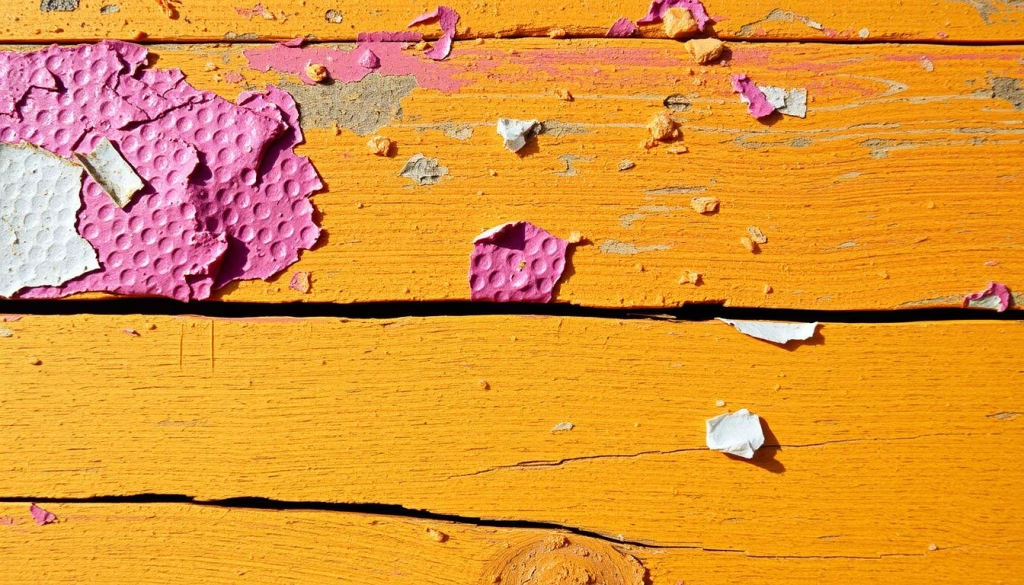
“Proper surface preparation and using high-quality paints can help prevent paint blistering and other common issues.”
Maintenance Tips for Painted Wood Surfaces
Keeping your painted wood surfaces looking great is key. It helps them stay beautiful and saves you money on repairs. Regular wood paint maintenance is crucial for both indoor and outdoor projects.
Begin by cleaning the wood gently with a mild detergent and warm water. Stay away from harsh chemicals like vinegar, bleach, or ammonia. Use paint touch-ups quickly to fix any chips or peels, keeping your furniture or structures looking unified.
- Check your painted wood every year for wear or damage, like fading, cracking, or peeling.
- Have extra paint ready for future touch-ups to blend repairs seamlessly.
- Apply a good sealant or topcoat every few years to protect the paint and boost outdoor paint longevity.
- Place furniture and structures where they won’t get direct sunlight to prevent color fading.
- Keep the environment stable with consistent humidity and temperature to avoid paint issues from wood changes.
By following these easy maintenance tips, you can make your painted wood surfaces last longer. They will stay looking great for many years.
| Cleaning Product | Dilution | Application |
|---|---|---|
| Dish Soap | 2-4 tablespoons per 2-4 inches of warm water | Use a damp microfiber cloth and smooth circular motions |
| White Vinegar | 2-4 tablespoons per 2-4 inches of warm water | Use a damp microfiber cloth and smooth circular motions |
| All-Purpose Cleaner | 2-4 tablespoons per 2-4 inches of warm water | Use a damp microfiber cloth and smooth circular motions |
| Ammonia | 1 part ammonia to 8 parts water | Use a damp microfiber cloth and smooth circular motions |
| Baking Soda | Mix with water to form a paste | Apply with a damp microfiber cloth and gently scrub |
Remember, proper wood paint maintenance is vital for keeping your painted wood surfaces beautiful and lasting. By using these tips and techniques, your indoor and outdoor projects will stay looking great for years.
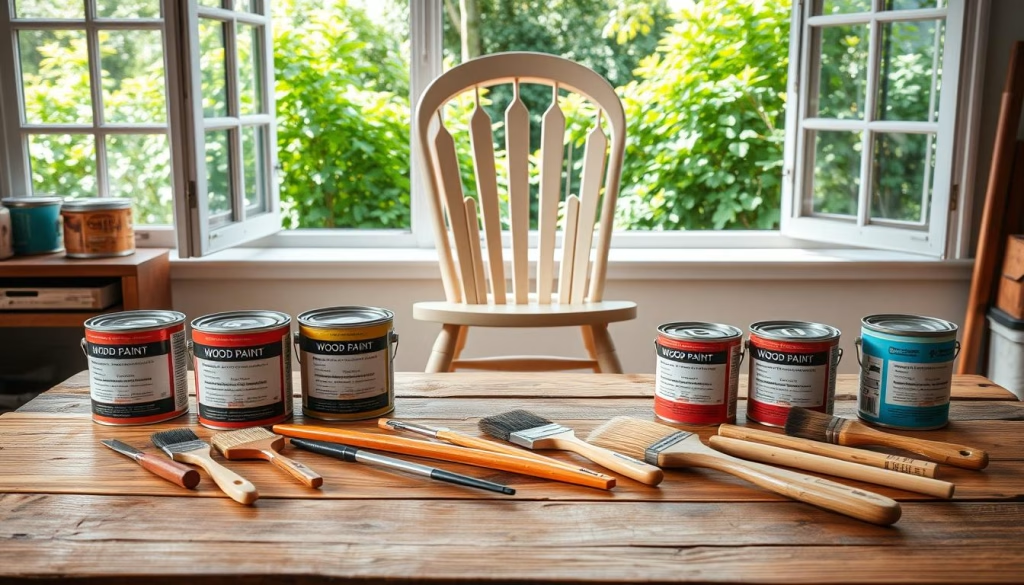
Sustainable Wood Painting Practices
Using sustainable wood painting practices helps reduce environmental harm. Many paints today have low volatile organic compound (VOC) levels. This makes them safer for indoor air and health.
When picking paint, look for “low-VOC” or “zero-VOC” labels. These paints are safer and better for the planet.
Good planning and waste management are key to sustainable painting. Measure paint carefully to avoid waste. Look for ways to reuse or dispose of leftover paint safely.
Check with local authorities for paint disposal rules. This helps keep our environment clean.
Choosing eco-friendly painting methods makes your work beautiful and eco-friendly. It also helps reduce your carbon footprint. Every small step we take helps make our world greener and healthier.
FAQ
What are the main types of wood paint?
There are three main types of wood paint: oil-based, latex, and acrylic. Oil-based paints are durable and resist moisture but have a strong smell and take longer to dry. Latex paints are easy to apply, dry quickly, and resist UV rays. Acrylic paints offer great coverage and fade resistance but may not last as long as oil-based paints in harsh weather.
What features should I look for in a quality wood paint?
Look for wood paint that is durable, weather-resistant, and keeps its color well. It should also have low VOC levels. High-quality paints protect wood better and last longer. They should handle your local weather well, especially for outdoor projects. Low VOC paints are better for the environment and your health.
What are some top wood paint brands to consider?
Top wood paint brands include Benjamin Moore, Sherwin-Williams, and Rust-Oleum. Benjamin Moore paints are known for their color retention. Sherwin-Williams offers a wide range of paints for different wood surfaces. Rust-Oleum provides good value with durable paints.
How do I choose the right wood paint for my project?
Choose the right paint by considering the wood surface, whether it’s for indoors or outdoors, and the color you want. For outdoor projects, pick paints that resist weather. For indoors, focus on paints with low VOC levels. Use neutral colors like tan and beige for exteriors to fade less. Bolder colors are okay for more protected areas like front doors.
What steps should I take to prepare the wood before painting?
Preparing the wood is key for a good paint job. Clean it well, sand it to smooth out the surface, and fix any damage. Priming is often needed, especially for outdoor projects or when changing paint types. Some paints come with primer, but separate priming can help with better adhesion and coverage.
What are the best techniques for applying wood paint?
The best techniques involve choosing the right tools and methods. Brushes, rollers, and sprayers each have their own benefits. Applying thin coats multiple times works better than one thick coat. Always follow the manufacturer’s drying time instructions between coats. For outdoor projects, plan your painting around the weather.
When should I use sealers and topcoats?
Use sealers and topcoats for extra protection and to make painted wood last longer. They’re especially important for outdoor projects. Choose sealers that match your paint type and are suitable for your project. Eco-friendly options are available for those who care about the environment.
How can I troubleshoot common painting issues?
Common issues include blistering, streaking, and fading. Blistering is often due to moisture or a dirty surface. Streaks come from bad application. Fading is more common with bright colors and sunlight. Good preparation, quality paints, and proper application can prevent these problems.
How do I maintain painted wood surfaces?
To keep painted wood looking good, clean it gently, fix any damage quickly, and reapply paint or sealant as needed. For outdoor projects, check for wear or damage every year. Keep extra paint for touch-ups. Proper care can make your paint job last longer.
What sustainable practices should I consider for wood painting?
Sustainable painting means using eco-friendly paints with low VOC levels, reducing waste, and disposing of paint responsibly. Many paints are now eco-friendly. Plan carefully to avoid waste. Check local rules for disposing of paint and materials to protect the environment.
Source Links
- The Best Exterior Paint For Wood
- Best Paint for Wood | Interior and Exterior Wood Paint | Vista Paint
- What Kind of Paint To Use On Wood Furniture: The Pros and Cons
- Best Paint for Wood: How to Choose – Hardwood Bargains Blog
- The 6 Best Paint Types for Furniture
- Choosing the Best Types of Wood For a Painted Project
- Wood Paint Types (A Guide To Choosing The Right One)
- 4 Best Furniture Paints in 2024
- Buying the Best Paint for Wood Means Nothing Without This Important First Step
- What Is The Best Paint On Wood? A Handy Guide – SCHEMES
- Ultimate Guide Choosing the Best Paint for Wood Crafts
- How to Paint Wood Like a Pro
- How To Paint Bare Wood
- How to Paint Furniture | Lowe’s
- Acrylic paint on wood: 7 steps & tips | Vaessen Creative
- 6 Tips for Painting Interior Woodwork
- Painting On Wood: Tips and Tricks
- Water Based Topcoats and Sanding Sealers
- Achieve a Smooth Finish with Acrylic Paint on Wood Furniture
- 15 paint problems & how you can fix them
- 6 Common Paint Problems & How to Fix Them
- How to Clean Painted Furniture the Safe and Simple Way
- Maintaining Wooden Furniture: Cleaning and Care Tips for Painted Pieces – Sadolin UK
- Simple Ways to Clean Painted Wood: 10 Steps (with Pictures)
- Eco-friendly Paints and Stains
- Sustainability in Art: Eco-Friendly Practices And Green Initiatives
- How to Make Plant Paints: Zero Waste Art – Greenify Me


